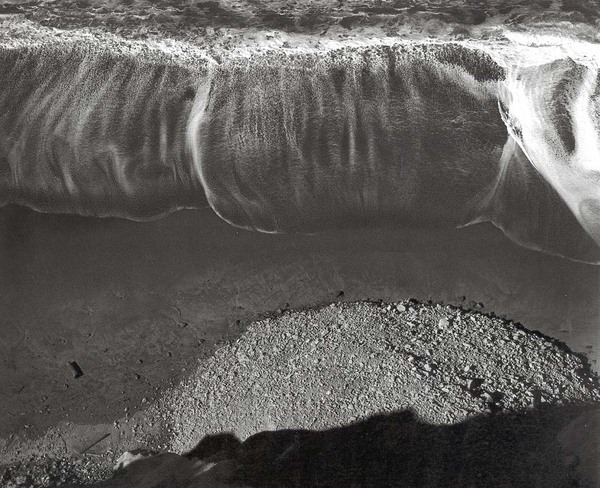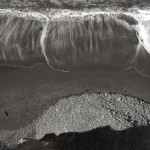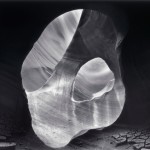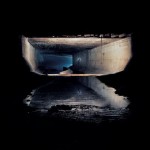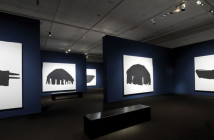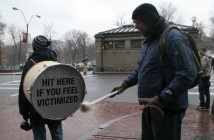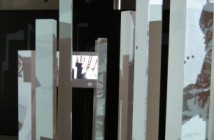FIRST DOUBT @ YALE UNIVERSITY ART GALLERY
The work at First Doubt, Yale’s latest contemporary art exhibition plays with our instinct to find the informational detail in a photographic image. Our eyes are put to the test with photos that focus on remarkable optical illusions within mundane objects, create unfamiliar compositions, and use the latest technology to capture images our eyes can’t normally process.
Photography has always differed from other mediums in the way it directly documents and represents scenes from the world we know and live in. Images captured in a photo should be able to refer directly to something familiar or fathomable. However, upon the advent of the twentieth century, within the context of Modernism, photographers began to abstract everyday subject matter. Cubism, aWorld War, better lenses, and a huge consumer photography market influenced art photography. For a generation, with the gesture of a camera instead the gesture of a paintbrush. photographers tried to prove that photography was an art because of it's ability to flatten the world visually.
Many of the works are remarkable as individual experiences, but what’s unique about this exhibition is the way that groupings of photographs interact with one another, connoting different formal readings with every view. To test this theory, the show will be taken down and re-installed a total of four times in its duration at Yale to see how a new perspective can create fresh relationships and associations among these images. The first two installations were choreographed by four teens working with Brian Scholl – associate professor of psychology at Yale. The third and fourth installations were organized by twelve students participating in the exhibition’s Master Class. Carrying this knowledge around the gallery walls is also exciting for the viewer, as it encourages you to make you own connections between different images and play curator.
Carefully selected walls and groupings of abstract photographs create a dynamic environment for the viewer to read many different possibilities into the uncertain and ambiguous space in each shot. Ansel Adams’ Untitled #2 from Surf Sequence is a fascinating piece that reveals the stark contrast of color and texture between ocean, surf, dry and damp sand, and the wild organic lines that result from the movement of the water over this uneven surface. Paired with Karin Rosenthal’s Belly Landscape, Adams’ beach scene looks like a confusing perspective of rolling hills and valleys. Belly Landscape, which features a torso half-submerged in water, is undoubtedly influenced just as strongly by Adams’ photo, as the viewer walks toward it with the expectation of a landscape.
Some pairings deal with totally unrelated subject matter, and yet share abstract formal qualities which draw them together. My favorite coupling combined a rustic nature scene with a portrait of a young driver. Dave Bohn’s John Hopkins Inlet, Glacier Bay is a tight shot of the complex pattern of light cast over the contours of a glacier. Strangely, these photos speak to one another; the pattern created by the girl’s hair creates the same shapes and rhythm found in the glacier.
Some photos in the exhibition play a charade, posing as one form and then slowly acquiescing into their true form after intense scrutiny. Some photos contain perfectly recognizable imagery, but are cropped to invent optical illusions that would not exist if the scene were viewed in life. Lou Stoumen’s piece Interior Light #36 captures a narrow view of the brick walls in an alley connecting crowded apartment buildings. Without any sense of street, sky, or figures to give a sense of depth to the space, the brick mass appears to enclose around the viewer. With a single window sitting staring at the viewer between the impending brick walls, the artist actually creates the illusion of a house built inside out.
The photograph In Peekaboo Canyon, by Bruce Barnbaum, captures a confusing vantage point from within a dark cavern. As light breaks through from the outside it highlights the stark contrast between the dry and dusty cracked stone of the ground and the smooth, glossy and bright graphic facets of the Canyon itself.
Another fascinating contrast of texture and light occurs in Naoya Hatakeyama’s Underground which features a camera perched on a tripod capturing a scene in an underground sewer. Water on the damp granite ground creates a glittering texture and the flash from the camera itself illuminates the different shades of contrasting color in the damp sewer. Capturing spaces that are usually hidden from view. Reflecting light both off the water and the concrete, it is as though there are two entirely different photographs place together, highlighting the illusions inherent in reflection, whether off solid surfaces or liquid. In this same vein, Tim Davis’s The Oarsman is a simple image of chipping paint on an oar, reflecting the color palette of an early morning sky. Above this photograph sits a intimate cropped portrait of an aged human face with a complex pattern of wrinkled and aged skin. On the next wall, a swimmer’s bald head reflects an overhead light which correspondingly shimmers on the surface of the pool.
Allowing for the interactive curation was like a Rorschach test, testing formal and subjective associations. The fascinating part of having a psychologist facilitate others in curating is that if fulfills many of these artists' intent. Playing on incongruities of our perception, we tend to mine our subconscious for something familiar. In the flux, we might be left in a state of confusion, fear, or desire - which can manifest physically as a rush of blood. Though, many of the photographs have lost this power over time, due to the fact that many of them are ready recognizable and, in fact, collectable. Through a motivated effort, this show can be used a a teaching tool. There remains an academic investment in trying to facilitate this original modernist aesthetic again, even if these photographs serve only as mere symbols to the perceptual ability they once had.
- Ansel Adams, Surf Sequence #2, silver gelatin print, 1973.
- Bruce Barnbaum, In Peekaboo Canyon, silver gelatin print, 1987
- Naoya Hatakeyama, from the series, Underground, chromogenic print, 1999.
"First Doubt: Optical Confusion in Modern Photography" is on view until January 4th at the Yale University Art Gallery, located at 1111 Chapel Street (at York Street), Yale University, New Haven, CT.
All images are courtesy of Yale University Art Gallery.

